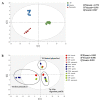Impact of Grape Pomace Powder on the Phenolic Bioaccessibility and on In Vitro Starch Digestibility of Wheat Based Bread
- PMID: 33673445
- PMCID: PMC8025819
- DOI: 10.3390/foods10030507
Impact of Grape Pomace Powder on the Phenolic Bioaccessibility and on In Vitro Starch Digestibility of Wheat Based Bread
Abstract
Breads were prepared by substituting common wheat flour with 0 (GP0), 5 (GP5) and 10 (GP10) g/100 g (w/w) of grape pomace powder (GPP) and were analyzed for the phenolic profile bioaccessibility as well as the in vitro starch digestion during simulated digestion. The free and bound phenolic composition of native GPP and resulting breads were profiled using ultra-high-performance chromatography-quadrupole-time-of-flight (UHPLC-QTOF). The raw GPP was characterized by 190 polyphenols with the anthocyanins representing the most abundant class, accounting for 11.60 mg/g of cyanidin equivalents. Regarding the fortified bread, the greatest (p < 0.05) content in phenolic compounds was recorded for the GP10 sample (considering both bound and free fractions) being 127.76 mg/100 g dry matter (DM), followed by the GP5 (106.96 mg/100 g DM), and GP0 (63.76 mg/100 g DM). The use of GPP determined an increase of anthocyanins (considered the markers of the GPP inclusion), recording 20.98 mg/100 g DM in GP5 and 35.82 mg/100 g DM in GP10. The bioaccessibility of anthocyanins increased in both GP5 and GP10 breads when moving from the gastric to the small intestine in vitro digestion phase with an average value of 24%. Both the starch hydrolysis and the predicted glycemic index decreased with the progressive inclusion of GPP in bread. Present findings showed that GPP in bread could promote an antioxidant environment in the digestive tract and influence the in vitro starch digestion.
Keywords: anthocyanins; antioxidant activity; bread fortification; foodomics; grape pomace; starch digestion.
Conflict of interest statement
The authors declare no conflict of interest.
Figures


References
-
- Mainente F., Menin A., Alberton A., Zoccatelli G., Rizzi C. Evaluation of the sensory and physical properties of meat and fish derivatives containing grape pomace powders. Int. J. Food Sci. Technol. 2019;54:952–958. doi: 10.1111/ijfs.13850. - DOI
-
- Beres C., Costa G.N.S., Cabezudo I., da Silva-James N.K., Teles A.S.C., Cruz A.P.G., Mellinger-Silva C., Tonon R.V., Cabral L.M.C., Freitas S.P. Towards integral utilization of grape pomace from winemaking process: A review. Waste Manag. 2017;68:581–594. doi: 10.1016/j.wasman.2017.07.017. - DOI - PubMed
-
- Bordiga M., Travaglia F., Locatelli M. Valorisation of grape pomace: An approach that is increasingly reaching its maturity—A review. Int. J. Food Sci. Technol. 2019;54:933–942. doi: 10.1111/ijfs.14118. - DOI
Grants and funding
LinkOut - more resources
Full Text Sources
Other Literature Sources
Miscellaneous

